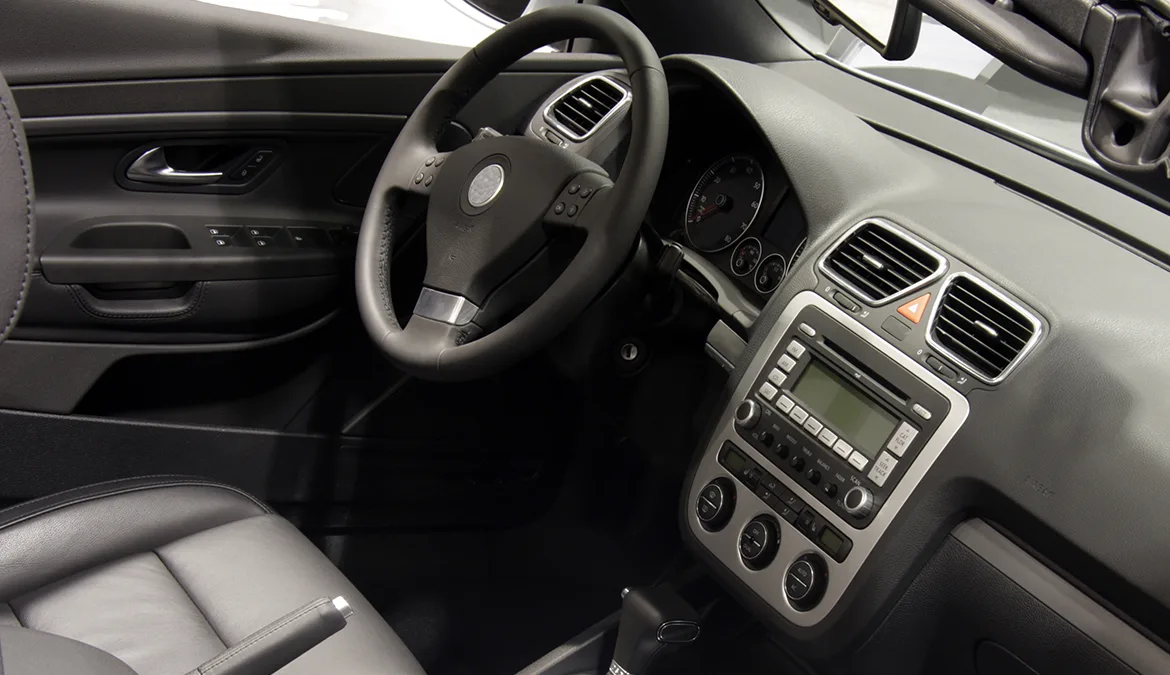Buying a Used Car: Interior Checklist

We’ve already gone over basic engine inspections when buying a used vehicle, but what about the interior? You can tell a lot about the car and its potential issues from the condition of the interior. From leaks to frame damage, here’s a list of things to look for when you’re inspecting the interior of a used vehicle.
Odor
As soon as you open the door try to see if there are any strange odors. Does it smell acrid, or like cigarettes? Does it smell musty or moldy? Or does it smell like somebody recently sprayed air freshener or perfume? That may mean that they’re trying to mask an unpleasant odor, as the interior of the car should have a pretty neutral scent.
Seats and Upholstery
Start with the seats. Look for tears and rips in the upholstery, and scuffs if the seats are leather. Make sure the seats don’t have any wet spots, as that could indicate a leak from the roof of the vehicle. Don’t just check the driver seat either, look at the passenger seat and back seats as well.
Check to see if the seats move freely, and if they’re power seats, that they move in every direction via the controls. If you need to make a seating adjustment on the road, the power seats need to work properly so you can adjust to a safe and comfortable driving position.
Make sure the seatbelts work, too. Check the straps, buckles, and retractors. The seats are where you’ll be spending most of your time, and the seatbelts will keep you there in case of an accident. Make sure to thoroughly inspect them.
Floormats
Pull up the floormats, both on the driver and passenger sides. Check for wet spots to make sure nothing is leaking from either the ceiling or the heater core on the passenger side. It’s a good idea to check for soft spots by gently hitting the ground as well, as this could indicate rust on the floor of the vehicle.
Look at the pedals. There’s no definite way to tell, but compare the mileage to obvious wear on the pedals. If the seller claims the car has 40,000 miles on it but the pedals are completely worn down, that may be a sign of odometer fraud. If it’s a car with lower miles, the pedals should look nice and new. The rubber should be intact, and metal shouldn’t be showing through.
Trunk
Look inside the trunk for pooling water or wet spots, both of which could mean leaks. Check in the spare tire well for water too, if the vehicle has one. Make sure the frame around the spare tire well hasn’t been damaged. Tire wells are difficult to repair if the frame has been bent, so a damaged well could show that the car has been in a rear-end collision.
Electronics
Check all the electronics. If there’s a fob key, make sure that all the buttons work: lock, unlock, alarm, and so forth. Then, put the key in the ignition and turn it over without turning the vehicle on. Make sure that the instrument cluster responds to the key being placed in the ignition, all the indicators should turn on for a few seconds.
Make sure all the lights are working, and all power accessories are working too. This includes seats, windows, sunroof, etc. If the car has a sound system, turn it on to make sure it works and none of the speakers are blown out. If the car has a touchscreen display – push all the buttons! If there’s a sunroof, look around it for leaks. Check the edges for any moisture or residual water damage. Open and close it to make sure it seals properly.
Turn on the AC and listen for the air compressor to click on. Make sure the air is blowing cold. If the car isn’t warmed up, the air won’t be cold but it should still be blowing. Keep in mind that when somebody tells you that the ‘air conditioner needs a charge,’ that means that the AC may be low on refrigerant. That typically comes from a leak in the system and is never as simple as simply refilling the fluid.
Turn the heater on too, and make sure it’s blowing hot air.
Exterior
This post is mostly about the interior of the vehicle, but there’s some quick things to check around the outside too. Aside from glaringly obvious damage, of course. When you look at the exterior, check all the panel gaps. Doors, trunk, hood, everything. Make sure they’re all nice and even. If the gaps between panels change size that may mean that it was involved in an accident and the frame was damaged
You can also bring a magnet with you to test for body filler – things like Bondo and JB Weld aren’t magnetic. If you see an area of the exterior that looks like it may have been previously damaged, try to touch a magnet to it. If it isn’t sticking, that may indicate that the area has been patched up or repaired with relatively cheap means. Before you even see the vehicle, do your research. Look up common issues with the vehicle you’re inspecting. Bring a mechanic or a car-savvy friend with you if you can. Get a ClearVIN VIN Check Report or perform a license plate number lookup to avoid pitfalls. Check out our available vehicles and find one near you to test out your new car inspection skills!
- The Advantages of Salvage Car Parts - November 3, 2025
- Buying Salvage Cars: What to Expect on Auction Day - May 22, 2025
- Is Buying a Hail Damage Car Worth It? A Detailed Guide - December 2, 2024